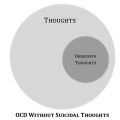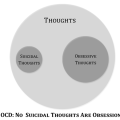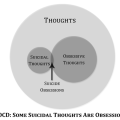Suicide Obsessions: Fear of Killing/Harming Yourself
Posted by Steven J. Seay, Ph.D. in Obsessive-compulsive disorder (OCD)
Suicide obsessions involve the fear of killing yourself, whereas self-harm obsessions focus on the fear of self-mutilation.
Thoughts of death, dying, and suicide are an unfortunate reality for many individuals. In the U.S. alone between 2008 and 2009, approximately 3.7% of adults (8.3 million Americans) reported having suicidal thoughts (Crosby et al., 2011).
During that same time frame, approximately 2.2 million U.S. adults reported making specific plans to commit suicide. An estimated 1 million Americans attempted suicide, and 36,035 individuals died as the result of suicide.
Clearly, suicidal thoughts and actions impact a significant number of Americans.
Although suicidal thoughts are most often associated with depression, suicidal thoughts are not experienced exclusively by those who are clinically depressed. Suicidal thoughts may also accompany other mental health conditions and may even occur in healthy individuals in the general population.
Not all thoughts related to suicide pose the same level of risk. Suicidal thoughts can range in intensity. Some thoughts may be fleeting, whereas others may involve detailed planning of the suicidal act. In addition to variations in the level of danger associated with different types of suicidal thoughts, some individuals may be at a greater/lower risk for acting on their thoughts.
Suicide obsessions are a specific category of suicidal thoughts that are unique to individuals with OCD. If you’ve read my previous posts on harm obsessions, you might conceptualize suicide obsessions as aggressive obsessions directed inward. Suicide obsessions involve repetitive, unwanted thoughts of suicide that cause severe distress. In contrast to other types of suicidal thoughts, suicide obsessions are symptoms of OCD that do not reflect a “true” intention to kill or harm oneself but rather reflect a repetitive thought loop that gets stuck.
Suicide obsessions can occur spontaneously, seemingly out of nowhere, or may be triggered by unpleasant (or even pleasant!) activities. These repeated, unwanted thoughts about death, suicide, or self-harm may occur many times throughout the day.
Not all obsessions in this category involve death. Some individuals have unwanted thoughts involving self-injurious or self-mutilating behaviors, which instead might be more accurately referred to as “self-harm obsessions” rather than “suicide obsessions.”
Suicide Obsessions & Self-Harm Obsessions
Here are some common examples of suicide and self-harm obsessions.
- Fear of committing suicide in the absence of a desire to do so (e.g., fear of slitting your wrists, hanging yourself, or overdosing on medications).
- Fear of becoming depressed and then feeling compelled to commit suicide.
- Fear of jumping off of a building or another high place.
- Fear of stepping out into oncoming traffic and being hit by a car.
- Fear of jumping in front of an oncoming train or subway.
- Fear of sticking your head in a hot oven.
- Fear of putting your hand in a blender and turning it on.
- Fear of grabbing ahold of a hot pan or stove burner.
- Fear of putting your arm down the garbage disposal and turning it on.
- Fear of driving off bridges or intentionally crashing head-on into other vehicles.
- Fear of intentionally disfiguring your face with a curling iron.
- Fear of intentionally crushing your car or yourself under the garage door.
- Fear of losing control and intentionally blinding yourself.
- Fear of mutilating yourself in other ways listed above.
Unwanted Suicidal Thoughts & Self-Harm Obsessions
Suicide and self-harm obsessions can be experienced in several different ways. Some individuals fear acting on their unwanted suicidal thoughts (i.e., actually killing or harming themselves), whereas others fear the moral or spiritual implications of simply having unwanted thoughts related to suicide or self-harm. For example, some people worry that having thoughts about suicide means they are “bad,” “evil,” or “sinful.” Others fear that thoughts of committing suicide may signal something dangerous, such as the onset of depression, schizophrenia, or another type of severe mental illness.
Suicide obsessions may consist of thoughts (“I want to kill myself.”) but they may also be experienced as impulses (“What if I lose control, pick up that knife, and kill myself?”) or images (e.g., mental movies focusing on self-harm behaviors like cutting, shooting, hanging, or overdosing). Regardless of the form, in many cases, suicide and self-harm obsessions are accompanied by thoughts like, “What if I secretly want to follow through on these thoughts?”
Individuals who know for sure that they want to commit suicide or engage in self-harm ARE NOT having suicide obsessions.
Suicide obsessions occur in the absence of a desire to hurt oneself, or they may be associated with debilitating doubt about whether or not one wants to act on their thoughts. Unfortunately, many individuals with OCD who have obsessions involving suicide cannot tell if their thoughts reflect obsessions or true desires to harm themselves.
The doubt and uncertainty that are characteristic of OCD make this determination difficult, if not impossible. This is further complicated by the fact that attempts to determine unequivocally if these thoughts reflect obsessions or true desires can turn into a mental checking ritual. This is problematic in that mental checking rituals, such as intention checking, actually perpetuate OCD and increase symptoms in the long run.
Because many individuals with OCD also have comorbid depression, it can be confusing to differentiate suicidal obsessions (a symptom of OCD) from suicidal thoughts related to depression. One clue may be the primary emotion associated with the thoughts. In cases of suicidal obsessions, the predominant emotion tends to be anxiety, fear, or horror. Individuals with suicide obsessions are usually terrified about the prospect of acting on thoughts about killing or harming themselves. Suicidal thoughts linked to depression tend to be somewhat less fear-based and instead are more likely to be associated with feelings of hopelessness or depression (both of which, incidentally, can also occur in OCD).
Let’s summarize some possible differences between suicidal obsessions and suicidal thoughts.
What are some characteristics of suicide obsessions (unwanted suicidal thoughts)?
- Suicide obsessions tend to be associated with fear about the possibility of acting on suicidal thoughts.
- In some cases, suicide obsessions may be primarily associated with fear about the implications of having suicidal thoughts — e.g., the fear of being bad or sinful, the fear of offending God, the fear of becoming depressed, the fear of developing a severe mental illness, or the fear of having to undergo an involuntary psychiatric hospitalization.
- Suicide obsessions involve unwanted suicidal thoughts, whereas self-harm obsessions involve unwanted thoughts of hurting oneself.
- People who have suicide obsessions do not want to act on their thoughts, or they may be unsure about whether they “really” want to act on their thoughts.
- People with suicide obsessions often feel extremely guilty about their suicidal thoughts.
What are some characteristics of suicidal thoughts?
- Suicidal thoughts related to depression may be more likely to be associated with hopelessness and despair.
- Individuals with suicidal thoughts may be extremely distressed and may want to act on their thoughts.
- Individuals with suicidal thoughts may be more likely to have a history of suicide attempts or self-injurious behaviors.
- Individuals with suicidal thoughts may be more likely to spend time deliberately planning how they would like to kill themselves.
Clearly, the above criteria are ambiguous. As such, it can be exceedingly difficult to differentiate suicidal obsessions from other types of suicidal thoughts.
To complicate things even further, it is important to note that people with OCD can also have suicidal thoughts that are not obsessions. For example, some individuals become so distressed by their obsessions that they begin to contemplate suicide.
Remember that in contrast to other types of suicidal ideation, suicidal obsessions (by definition) do not reflect an actual intention or desire to hurt oneself.
Let’s take a look at the different ways that suicidal ideation might manifest, which are depicted in the figures below…
Suicide Obsessions vs. Suicidal Thoughts
Please note: These categories are hypothetical constructs only and merely reflect the way I conceptualize suicidal thoughts across individuals with and without OCD. To my knowledge, no published research studies have been conducted to determine the prevalence rates of these presumed categories.
Suicide Obsessions – Descriptions
Figure 1 is the simplest figure and illustrates a person without OCD who is experiencing suicidal thoughts. This person does not have OCD, and thus, does not have suicide obsessions. For example, this figure might represent a person who is clinically depressed but does not have OCD.
Figure 2 is also a relatively uncomplicated scenario. As you can see, this figure depicts an individual with OCD who does not have suicidal thoughts. For example, this figure might reflect a person who has obsessions about germs or contamination but who does not have thoughts of suicide.
Starting with Figure 3, things get a bit more complex. Individuals in this category have both obsessions and non-obsessive suicidal thoughts. Examples of people fitting in this category include people with checking compulsions who are feeling so hopeless that they begin to think about suicide as being one option for alleviating their distress. As described earlier, suicidal thoughts vary greatly. Some individuals may have fleeting thoughts of suicide (“I can’t take this anymore, maybe I would be better off dead.”), whereas others may develop specific plans to end their own lives.
Figure 4 is the first figure to depict suicide obsessions. As you can see, this figure shows an individual with OCD whose suicidal thoughts consist exclusively of suicidal obsessions. Individuals falling into this category include people with Pure-O OCD who have intrusive, repetitive thoughts about suicide or self-harm. These obsessions often involve scary, violent images involving suicidal acts or behaviors. These thoughts are frequently shocking and horrifying. Suicide obsessions may “spike” unexpectedly and can literally take one’s breath away… Individuals with suicide obsessions frequently worry about losing control and acting on their unwanted impulses (e.g., “What if I snap and hurt myself?”) or feel incredibly guilty for having such thoughts.
Suicidal obsessions are very confusing for sufferers. Individuals with suicide obsessions are typically horrified by the prospect of committing suicide or engaging in self-harm. Just as in other forms of OCD involving unwanted thoughts, individuals with suicide obsessions often feel that their suicidal thoughts are meaningful or dangerous. They believe that they shouldn’t be having such thoughts and worry that these thoughts must reflect a true, underlying desire to commit suicide.
However, because in Figure 4, all suicidal thoughts are obsessions, the risk for attempted or completed suicide is likely reduced compared to individuals who have non-obsessive suicidal thoughts.
Figure 5 is the most complicated case. Individuals in this category experience both suicidal obsessions and non-obsessive suicidal thoughts. This scenario is particularly confusing for sufferers because it likely involves a combination of lower risk (i.e., suicidal obsessions) and higher risk suicidal thoughts.
For example, someone in this category might experience unwanted sexual obsessions, aggressive obsessions toward others, and suicide obsessions. Due the the overwhelming nature of these symptoms, the individual might also be depressed and may question whether or not life is worth living. For this person, death might seem preferable to a life that feels defined by a near-constant barrage of horrifying impulses and images.
One of the most frustrating aspects of suicide obsessions is that you can never know “for sure” into which category you fit best. I know some individuals with OCD who desperately want their symptoms to fit Category 4 rather than Categories 3 or 5. This is because all suicidal thoughts in Category 4 can be attributed to obsessions, which makes this category feel relatively “safe” compared to the alternatives.
Unfortunately, attempts to definitively categorize yourself are doomed to fail; just as with most things related to OCD, there are some things we can never really know with 100% certainty.
Thankfully, certainty is not a prerequisite for recovery, and there are evidence-based treatments for both depression and OCD (including treatments for suicide and self-harm obsessions).
If you are experiencing these symptoms, it’s important that you work with an individual therapist to address these issues.
Self-Harm Obsessions – Concluding Thoughts
This is a very sensitive topic, and I went back-and-forth many times about whether or not I should publish this article. On the one hand, I feel that these symptoms are a hidden, often agonizing symptom of OCD. Sufferers often don’t talk about these symptoms, and I think that it’s important to have access to information about this topic. After all, individuals who are experiencing these symptoms are often in a great deal of distress.
At the same time, true suicidal thoughts can pose fatal risks to some individuals, and I do not want individuals with OCD to mislabel their suicidal thoughts as suicidal obsessions if this is not actually the case. If you are having suicidal thoughts, it is critical that you work individually with a mental health professional in order to address these symptoms. Suicidal thoughts can be dangerous and should not be taken lightly.
For these reasons and due to the sensitive nature of this topic, I cannot respond to emails or queries regarding whether or not your symptoms reflect suicidal obsessions or actual suicidal thoughts. I cannot and will not make this determination.
This determination must be made by your provider on the basis of a formal psychological evaluation. For the same reason, I am also choosing to disallow comments on this post. My concern is that leaving comments open will potentially add more confusion to this already confusing topic.
Questions? Comments? Struggling with suicide or self-harm obsessions? Please discuss these symptoms with your provider.









